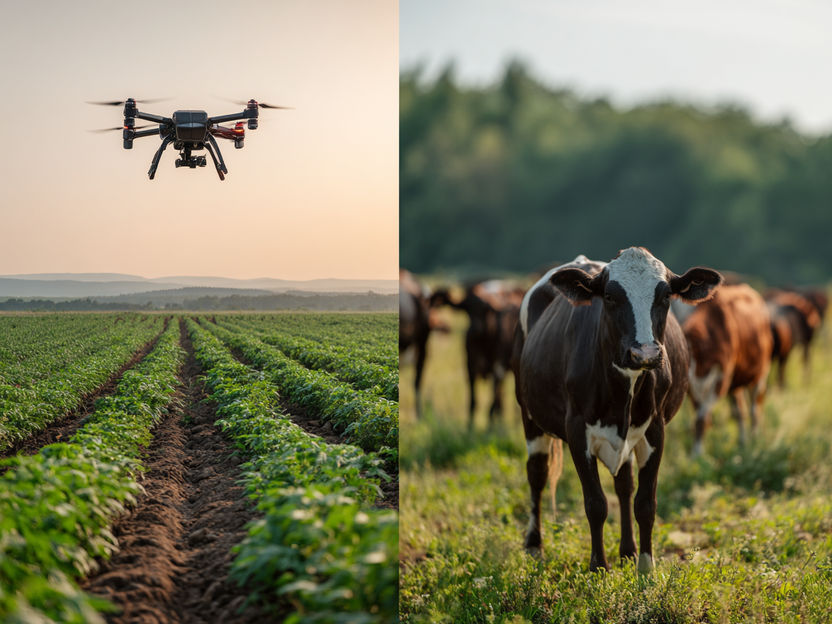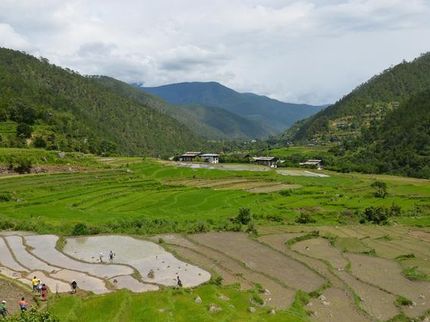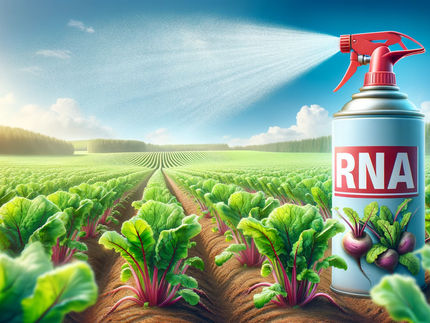Smart farming for everyone: How small farms can think big
More competitiveness, more sustainability, more animal welfare
drones over the field detect plant diseases at an early stage, autonomous robots plant young vegetables and artificial intelligence helps to calculate the feed requirements of grazing cattle: agriculture 4.0 stands for innovative technologies that fundamentally change everyday life on the farm. Even small farms can remain competitive through digitalization - and at the same time promote the environment and animal welfare. This is demonstrated by a research project at the University of Hohenheim in Stuttgart and the Nürtingen-Geislingen University of Applied Sciences (HfWU).

Symbol image
Computer-generated image
The potential is huge: from big data and agricultural sensors to customized software solutions, digital technologies can conserve resources, improve animal welfare and reduce operating costs. Large farms in Germany and abroad in particular are increasingly relying on these often capital-intensive innovations. However, small and medium-sized family farms, such as those often found in Baden-Württemberg, run the risk of being left behind by these developments and no longer being competitive in the future.
The "Digital value chains for sustainable small-scale agriculture" (DiWenkLa) project spent five years researching how they too can benefit from digital change. In a total of 14 sub-projects, the researchers looked at the opportunities that digitalization offers for smaller agricultural businesses.
"Digital technologies can not only reduce the workload and stabilize farm yields. They also help to protect the environment and nature as well as animal welfare and reduce the use of pesticides," emphasizes Prof. Dr. Enno Bahrs, project coordinator and agricultural scientist at the University of Hohenheim.
"To ensure that small farms can also benefit from this, our aim was to keep the acquisition costs as low as possible. That's why we mainly used solutions available on the market and customized some of them," continues the expert. "From our point of view, it also often makes sense for farms to join forces - similar to a machinery ring - when it comes to digitalization."
For example, the drones of a jointly contracted service provider could be used on various fields not only to detect and combat diseases, but also for irrigation monitoring or the early detection of forest fires. Overall, a whole range of applications are suitable for smaller farms - for example in animal husbandry.
More animal welfare through digitalization
Sustainable cultivation, regional feed, high-quality food and an ethically acceptable habitat for farm animals: consumers' demands for animal welfare and sustainability are increasing and becoming ever more complex. However, "the widespread desire to give cattle and other farm animals more access to pasture also has its pitfalls," says Prof. Dr. Eva Gallmann from the Centre for Animal Husbandry Technology at the University of Hohenheim.
"Today's cows are high-performance cows that need a feed supply tailored to their needs and performance," explains the expert. "In the barn, farmers have much better control over which feed the animals eat and how much of it. An undersupply leads to illness and poorer milk yield. An oversupply, on the other hand, leads to higher economic costs as well as an increased environmental impact, as some of the nutrients in the feed are excreted unused."
Farmers' personal commitment to their animals remains essential
This is why it is particularly important for grazing animals to know the quantity and quality of the green fodder they eat. Only then can farmers feed the animals according to their needs. For example, an instrument that works with near-infrared spectroscopy (NIRS) can be used to make precise statements about the quality of the forage. "So far, this device has only been used in the laboratory; its use in the field is quite new," says Prof. Dr. Gallmann.
Another measuring device records the growth height and thus helps to estimate how much and how quickly the grass grows back on a pasture. This data is fed into a ration planning app, which farmers can then use to better plan the necessary amount of supplementary feeding.
However, one thing remains particularly important for the scientist: "Even the most modern technology cannot replace the personal commitment of farmers to their animals!"
Efficient crop protection with optical sensors on drones
Prof. Dr. Ralf Vögele's working group from the Department of Phytopathology at the University of Hohenheim is working on the targeted use of plant protection products. The researchers there are investigating the question of how diseases in field vegetables can be detected as early as possible and countermeasures can be introduced in good time.
Various plant protection products against fungal diseases and pests are still often applied to the entire field at the same time. "This means that more plant protection products are applied than necessary," explains Christian Trautmann, a doctoral student in the working group. "It would make more sense to apply fungicides to prevent fungal diseases preventively and over the entire area, but only apply pesticides as required and depending on the infestation."
Optical sensors on drones can help. They measure altered light reflections from plants infested with fungi or pests at an early stage. Artificial intelligence (AI) analyzes the data and enables the use of agents to combat insect pests or spider mites. These can be applied specifically to the infested plants with the help of spraying drones.
Special challenge: AI in the field
"But this is also where the challenge lies," explains Christian Trautmann. "This is because the AI has to be trained individually for each crop and each damage pattern so that it can reliably detect infested plants under practical conditions. To do this, thousands of training data must first be evaluated and interpreted by humans."
A high level of effort that is probably most worthwhile for special crops such as fruit and vegetables. On the one hand, farmers are threatened with high losses in the event of crop failure; on the other hand, the demand for food that is as uncontaminated as possible has also increased.
Intelligent robot for soil-friendly planting
The strength of robotics is also evident in vegetable cultivation, where the workload is high. The multifunctional robot Phoenix from the University of Hohenheim has already proven its worth in various projects. In DiWenkLa, it is a real lightweight, planting cabbage seedlings at precise intervals without compacting the soil unnecessarily. An AI monitors the entire process and ensures optimum results.
Dr. Nils Lüling from the Department of Artificial Intelligence in Agricultural Engineering at the University of Hohenheim explains: "Our aim was to develop an autonomous solution. Thanks to AI-based monitoring, the planting unit can maintain a constant quality of work, even in fields with varying soil conditions, and react to errors."
Southern Black Forest and Stuttgart region as models for other regions
Two regions in Baden-Württemberg served as experimental fields: the southern Black Forest and the Stuttgart metropolitan region. They were chosen because they are two representative areas of agriculture in Baden-Württemberg.
The Stuttgart metropolitan region stands for areas that will focus primarily on the production of arable and field vegetables (cabbage and lettuce), cereals, soy and other crops in the future. In addition, there will be an increase in horse farming, which will be used as livestock and leisure animals. The advantage of metropolitan regions is that they already have highly networked digital structures.
In contrast, the southern Black Forest reflects the situation of low mountain regions, some of which have steep slopes. Typical for these regions are a lot of grassland, cattle farming and poorly developed digital structures. The selection of these two regions should enable the results to be transferred to other, similarly structured regions.
BACKGROUND: DiWenkLa - Digital value chains for sustainable small-scale agriculture
The focus of the research "Digital value chains for sustainable small-scale agriculture" (DiWenkLa) was a joint project with a total of 14 sub-projects. Under the leadership of Prof. Dr. Enno Bahrs from the Department of Agricultural Business Management, eleven departments at the University of Hohenheim were involved. The project partner was the Nürtingen-Geislingen University of Applied Sciences (HfWU). In addition to around 20 agricultural businesses, individual state institutes of the Ministry of Rural Areas and Consumer Protection in Baden-Württemberg and over 35 partners from industry, such as industrial and service companies, were also involved in the project.
The Federal Ministry of Food and Agriculture (BMEL) has funded the project since 2020 via the "Experimental fields for digitalization in agriculture" funding guideline with a sum of around 3.3 million euros for the University of Hohenheim. The total funding amounted to around 5.5 million euros. The project was completed in February 2025.
Note: This article has been translated using a computer system without human intervention. LUMITOS offers these automatic translations to present a wider range of current news. Since this article has been translated with automatic translation, it is possible that it contains errors in vocabulary, syntax or grammar. The original article in German can be found here.
Other news from the department science
Most read news
More news from our other portals
See the theme worlds for related content
Artificial intelligence (AI) for food and beverages
Artificial intelligence (AI) is optimizing the food and beverage industry through automated quality control and more accurate demand forecasting. AI plays a particularly important role in product development by analyzing taste preferences and market trends. This allows new products to be developed that are better tailored to consumer needs, increasing efficiency and customer satisfaction.

Artificial intelligence (AI) for food and beverages
Artificial intelligence (AI) is optimizing the food and beverage industry through automated quality control and more accurate demand forecasting. AI plays a particularly important role in product development by analyzing taste preferences and market trends. This allows new products to be developed that are better tailored to consumer needs, increasing efficiency and customer satisfaction.






























































